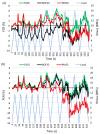Environment-Friendly, Self-Sensing Concrete Blended with Byproduct Wastes
- PMID: 32235570
- PMCID: PMC7180613
- DOI: 10.3390/s20071925
Environment-Friendly, Self-Sensing Concrete Blended with Byproduct Wastes
Abstract
Smart structures have attracted significant research attention in the last decade, mainly due to the capabilities of advanced concrete in electrical resistance-enabled self-sensing. In this study, we present a type of environment-friendly, self-sensing concrete enabled by electrical resistance. Environment-friendly, self-sensing concrete was casted with the additions of byproduct wastes (i.e., coal fly ash (FA), blast furnace slag (BOF) and red mud (RM)) at various volume fractions and cured using the conditions of 3, 7 and 28 days. The self-sensing concrete samples were experimentally tested to investigate the effects of the byproduct wastes on the mechanical and electrical properties (i.e., compressive strength and electrical resistance). In the end, parametric studies were experimentally conducted to investigate the influences of the byproduct wastes on the mechanical and electrical properties of the reported environment-friendly, self-sensing concrete.
Keywords: byproduct wastes; compressive strength; electrical conductivity; environment-friendly; self-sensing concrete.
Conflict of interest statement
The authors declare no conflict of interest.
Figures










References
-
- Monteiro P. Concrete: Microstructure, Properties, and Materials. McGraw-Hill Publishing; New York, NY, USA: 2006.
-
- Mehta P.K., Monteiro P.J. Concrete: Microstructure, Properties and Materials. McGraw-Hill Education; New York, NY, USA: 2017.
-
- Naik T.R. Sustainability of concrete construction. Pract. Period. Struct. Des. Constr. 2008;13:98–103. doi: 10.1061/(ASCE)1084-0680(2008)13:2(98). - DOI
-
- Lothenbach B., Scrivener K., Hooton R. Supplementary cementitious materials. Cem. Concr. Res. 2011;41:1244–1256. doi: 10.1016/j.cemconres.2010.12.001. - DOI
-
- Chindaprasirt P., Rukzon S. Strength, porosity and corrosion resistance of ternary blend Portland cement, rice husk ash and fly ash mortar. Constr. Build. Mater. 2008;22:1601–1606. doi: 10.1016/j.conbuildmat.2007.06.010. - DOI
Grants and funding
LinkOut - more resources
Full Text Sources
Research Materials
Miscellaneous

